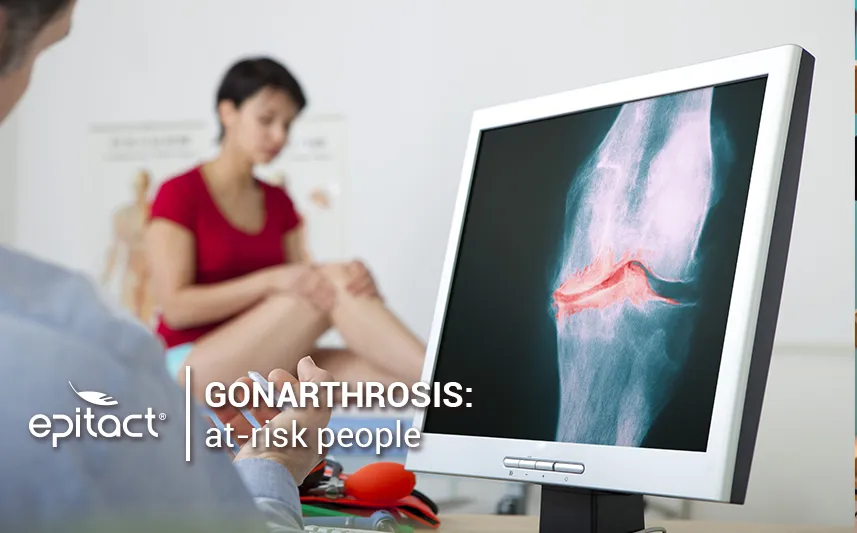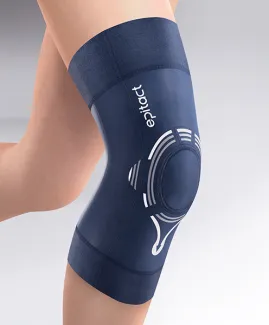
Find out who are the people at risk for arthritic knees and what are the aggravating factors of gonarthrosis. Gonarthrosis, or arthritic knee, is the most common joint condition. Which persons are the most affected or particularly at risk? What are the aggravating factors of arthritic knees? EPITACT® provides you some information about people at risk to preserve you from arthritic knees.
What is arthritic knee?
Arthritic knee is a deterioration of the knee joint cartilage that often results from natural wear. This condition can cause pain even at rest. However, we aren’t all equal because some people develop this condition whereas others don’t. The cartilage and synovial membrane quality seem to play a major role in the pathogenesis (the way the condition appears and develops).
Arthritic knee: who is concerned?
People having suffered traumas of the knee or lower limbs are more often affected by arthritic knees than the rest of the population. In addition, injuries to other joints (e.g. ankle, hip) can cause arthritic knee in compensation. Among these traumas, we can cite knee sprain or fracture. Indeed, these traumas may deteriorate the regeneration capacity of the cartilage.
Joint overuse with repeated movements during professional or sports activity contributes to arthritic knee. In this way, if you regularly practise activities implying repeated flexion and extension movements, you could become a person at risk, i.e. you’d be more prone to develop arthritic knees than others.
Some hereditary factors may also favour the development of this joint condition. Indeed, the fragility of the cartilage is involved like in rheumatoid arthritis, osteonecrosis or chondrocalcinosis.
More frequent from 50 or 60 years old, arthritic knee is the most common joint condition. Actually, age is an aggravating factor of osteoarthritis. According to the French National Institute for Health and Medical Research (INSERM), nearly 3% of people under 45 develop this condition against 80% of people over 80.
In women, menopause also seems to play a role in the bone fragility that hormone replacement therapies don’t treat.
Finally, metabolic disorders are also related to arthritic knees, especially diabetes and obesity.
What are the aggravating factors of gonarthrosis?
Overweight is another aggravating factor of arthritic knees. In case of high body mass index (BMI), the joint supports an excessive weight. Therefore, pain can appear in the knee which is under strain.
Lower limb deformity favours osteoarthritis, in particular arthritic knee. In genu varum, knees are distant from each other even when the legs are closed. Because the centre of gravity of the knee is displaced inwards (varum), pressure increases on the medial compartment of the tibiofemoral joint and intensifies the cartilage wear. In genu valgum (knock knees), the joint (external compartment) is also under excessive strains, likely to cause osteoarthritis.
Finally, if the knee presents anatomical or biomechanical dysfunctions, the patella (kneecap) may not have a natural track in the femoral trochlea. Consequently, a joint conflict is created, which may cause wear and tear of the patellofemoral cartilage. Most of the time, this wear occurs on the lateral and/or superolateral border of the patella.
Let’s remember that the knee joint is part of a whole. Then, involvement of the foot, ankle or hip can have consequences on its functioning.

Preventing arthritic knees
In order to limit the risks and preserve your joint, EPITACT® has developed a brace designed to protect and relieve pain associated with patellofemoral gonarthrosis. The light and discreet PHYSIOstrap™ MEDICAL* knee brace can be worn daily, under any clothes and for a long time. Its silicone and elastic tendons limit the deviation of the patella by guiding it, to support the joint and avoid pain.
Another version has been designed to be worn during sport and combines comfort and effort. Discover the PHYSIOstrap™ SPORT* knee brace developed by EPITACT®.
*These solutions are class I medical devices that bear the CE marking under this regulation. Carefully read the instructions before use. Manufacturer: Millet Innovation. 09/2021
 Pharmacie
Pharmacie
